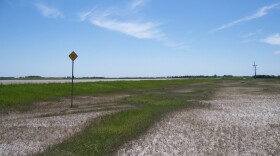When one looks out on those North Dakota pastures an observer may see “just grass.” It might surprise you, but North Dakota is home to around 150 species of grasses. Some of course are introduced, but the vast majority is native, ranging from buffalograsss to sloughgrass.
The grass family is one of the most important plant families. Our grain crops are domesticated grasses, and grasses form the bulk of forage for large herbivores around the world from North American bison to African wildebeest. And of course, the North Dakota grasslands are very important to the livestock industry.
Like other plant families, the various species of grasses occupy a wide range of habitats. Saltgrass for example is found in alkaline soils, a harsh environment for plants. Sand dropseed is largely restricted to sandy soils. The introduced Kentucky bluegrass on the other hand, can occupy a wide range of conditions.
Grasses can be categorized by season of growth. There are cool-season grasses such as western wheatgrass, the needlegrasses, and Kentucky bluegrass that grow best during the cooler days of spring and fall. They do not do well during the warmer days of summer. Conversely warm-season grasses such as blue grama, big bluestem, and switchgrass are slow to grow in the spring and become most productive during the warm days of summer which is too warm for the cool season species. A good way to relate to these differences is to think of the growth of wheat, a cool-season grass, as opposed to corn, a warm-season grass.
Grasses also differ in growth form, such as sod forming, or rhizomatous grasses versus bunchgrasses. They also can differ significantly in palatability and nutrition as they grow and mature. As such, grass species can differ markedly in how they respond to grazing. Think of a pasture as a giant smorgasbord. Livestock or big game might relish a grass during one period or season but ignore it in another. Some species are seldom used, while others are used heavily, and are occasionally referred to as “ice cream plants.” Ranchers and other grassland managers need to understand those differences to manage the resources more effectively.
Make a point of walking some native prairie this summer and observing the different grasses and the differences between them. There is much going on here, physiologically, ecologically, and in other ways. It is not all “just grass.”




